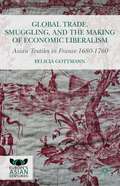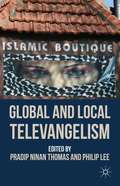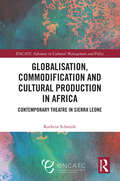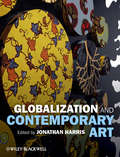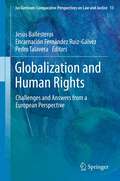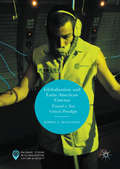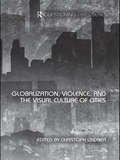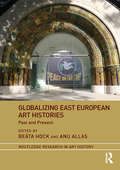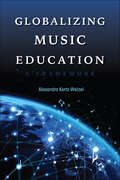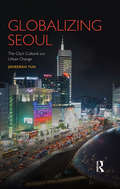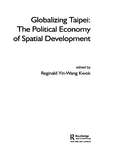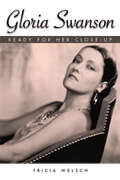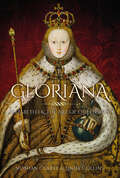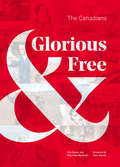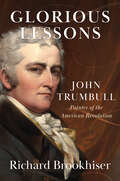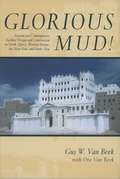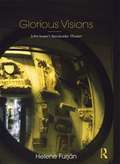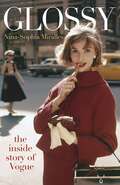- Table View
- List View
Global Trade, Smuggling, and the Making of Economic Liberalism: Asian Textiles In France 1680-1760 (Europe's Asian Centuries Ser.)
by Felicia GottmannImported from India, China, the Levant, and Persia and appreciated for their diversity, designs, fast bright colours and fine weave, Asian textiles became so popular in France that in 1686 the state banned their import, consumption and imitation. A fateful decision. This book tells the story of smuggling on a vast scale, savvy retailers and rebellious consumers. It also reveals how reformers in the French administration itself sponsored a global effort to acquire the technological know-how necessary to produce such textiles and how the vitriolic debates surrounding the eventual abolition of the ban were one of the decisive moments in the development of Enlightenment economic liberalism.
Global Urban Analysis: A Survey of Cities in Globalization
by Ben Derudder Frank Witlox Pengfei Ni Michael Hoyler Jin Huang Peter J TaylorGlobal Urban Analysis provides a unique insight into the contemporary world economy through a focus on cities. It is based upon a large-scale customised data collection on how leading businesses use cities across the world: as headquarter locations, for finance, for professional and creative services, for media. These data - involving up to 2000 firms and over 500 cities - provide evidence for both how the leading cities, sometimes called global cities, are coming to dominate the world economy, and how hundreds of other cities are faring in this brave new urban world. Thus can the likes of London, New York and Hong Kong be tracked as well as Manchester, Cleveland and Guangzhou, and even Plymouth, Chattanooga and Xi'an. Cities are assessed and ranked in terms of their importance for various functions such as for financial services, legal services and advertising, plus novel findings are reported for the geographical orientations of their connections. This is truly a comprehensive survey of cities in globalization covering global, world-regional, and national scales of analysis: - 4 key chapters outline the global structure of the world economy featuring the leading cities; - 9 regional chapters covering the whole world also feature the level of services provided by 'medium' cities; - 22 chapters on selected countries and sub-regions indicate global-ness and local-ness and feature an even wider range of cities. Written in an easy to understand style, this book is a must read for anybody interested in their own city in the world and how it relates to other cities.
Global Warming and the Built Environment
by D.K. Prasad R. SamuelsThe role of the built environment on global warming is seen to be of increasing relevance. In this book, contributors of international repute offer a wide perspectivet on the subject. This new paperback edition offers insights and techniques regarding design and management of buildings and urban settlement and discusses the issues of accountability and responsibility.
Global and Local Televangelism
by Pradip Ninan Thomas Philip LeeAn exploration of the many faces of televangelism in our world today, including Christian, Islamic and Hindu. The collection analyses the correspondences and major differences between global and local televangelism, focusing on the main individuals involved in televangelism, their practices and the social and cultural impact of their ministries.
Globalisation, Commodification and Cultural Production in Africa: Contemporary Theatre in Sierra Leone (ENCATC Advances in Cultural Management and Policy)
by Kathrin SchmidtThis book engages with contemporary cultural production in Africa, focusing on theatre in Sierra Leone as main case study. The author provides coverage of, and insights into, such themes as cultural globalisation, commodification, the global creative economy, culture and development, international relations and contemporary cultural production in Sierra Leone within the context of local and global flows of people, media, images, technologies, finance and ideas. Combining the analysis of theatre in Sierra Leone and its aesthetics with its policy, structural and institutional context, this book highlights in much detail and nuance the interconnectedness between the micro- and the macro-levels of cultural production, between the local and the global, and between aesthetics, politics, policy, governance structures and institutions. This book links the particular findings from the author’s fieldwork to larger issues of contemporary local cultural production within the context of globalisation, commodification and decolonisation; adds a postcolonial perspective to existing theories and approaches to cultural production, management and policy, which is still largely missing from the existing discourse; and also contributes to addressing the gap in the knowledge about the context of contemporary cultural productions in diverse African contexts. This book will be particularly useful for both theatre scholars with an interest in the political economy of theatre and, more broadly, those seeking to understand the nuanced challenges and opportunities faced by policymakers, artists and arts managers to embrace the cultural and creative industries in this context. It also offers excellent insights for policymakers who wish to improve their understanding and interventions beyond superficial ‘best practice’ snippets and simplified ‘success stories’.
Globalization and Contemporary Art
by Jonathan HarrisIn a series of newly commissioned essays by both established and emerging scholars, Globalization and Contemporary Art probes the effects of internationalist culture and politics on art across a variety of media. Globalization and Contemporary Art is the first anthology to consider the role and impact of art and artist in an increasingly borderless world. First major anthology of essays concerned with the impact of globalization on contemporary art Extensive bibliography and a full index designed to enable the reader to broaden knowledge of art and its relationship to globalization Unique analysis of the contemporary art market and its operation in a globalized economy
Globalization and Human Rights
by Jesús Ballesteros Encarnación Fernández Ruiz-Gálvez Pedro TalaveraGlobalisation turns out to be untenable because it does not guarantee minimum social equity, peace and respect for the environment, and therefore does not guarantee the effective accomplishment of human rights. This book analyzes this issue and raises proposals for a new perspective. The first part describes the soft threats to human rights, derived from the devaluation of the politics and the productive economy with regard to the finance. It entails the concealment of the reality in the shape of exploitation as the tax havens and in the shape of marginalization of the persons with different abilities. The second part include a study of hard threats to human rights and examines two cases of failed states: Afghanistan and Somalia, in which the violence has supplanted the politics and the economy. In view of these situations it is necessary to rethink the force of classic ius gentium and the humanitarian right. The third part presents the European Union as a legal and political space in which conditions of a worthy life are better defended by means of the Primacy of Practical Reason and Social State of Law, and by the requirement of peace as the main rule of international relations.
Globalization and Latin American Cinema: Towards A New Critical Paradigm (Palgrave Studies in Globalization, Culture and Society)
by Sophia A. McClennenStudying the case of Latin American cinema, this book analyzes one of the most public - and most exportable- forms of postcolonial national culture to argue that millennial era globalization demands entirely new frameworks for thinking about the relationship between politics, culture, and economic policies. Concerns that globalization would bring the downfall of national culture were common in the 1990s as economies across the globe began implementing neoliberal, free market policies and abolishing state protections for culture industries. Simultaneously, new technologies and the increased mobility of people and information caused others to see globalization as an era of heightened connectivity and progressive contact. Twenty-five years later, we are now able to examine the actual impact of globalization on local and regional cultures, especially those of postcolonial societies. Tracing the full life-cycle of films and studying blockbusters like City of God, Motorcycle Diaries, and Children of Men this book argues that neoliberal globalization has created a highly ambivalent space for cultural expression, one willing to market against itself as long as the stories sell. The result is an innovative and ground-breaking text suited to scholars interested in globalization studies, Latin-American studies and film studies.
Globalization, Violence and the Visual Culture of Cities (Questioning Cities)
by Christoph LindnerWhat connects garbage dumps in New York, bomb sites in Baghdad, and skyscrapers in São Paulo? How is contemporary visual culture – extending from art and architecture to film and digital media – responding to new forms of violence associated with global and globalizing cities? Addressing such questions, this book is the first interdisciplinary volume to examine the complex relationship between globalization, violence, and the visual culture of cities. Violence – in both material and cultural forms – has been a prominent and endemic feature of urban life in the global metropolitan era. Focusing on visual culture and offering a strong humanities perspective that is currently lacking in existing scholarship, this book seeks to understand how the violent effects of globalization have been represented, theorized, and experienced across a wide range of cultural contexts and urban locations in Asia, Europe, North and South America, and the Middle East. Organized around three interrelated themes – fear, memory, and spectacle – essay topics range from military targeting in Baghdad, carceral urbanism in São Paulo, and the Paris banlieue riots, to the security aesthetics of G8 summits, the architecture of urban paranoia, and the cultural afterlife of the Twin Towers. Globalization, Violence, and the Visual Culture of Cities offers fresh insight into the problems and potential of cities around the world, including Beijing, Berlin, London, New York, Paris, and São Paulo. With specially-commissioned essays from the fields of cultural theory, architecture, film, photography, and urban geography, this innovative volume will be a valuable resource for students, scholars, and researchers across the humanities and social sciences.
Globalized Arts: The Entertainment Economy and Cultural Identity
by J. P. SinghOur interactive world can take a cultural product, such as a Hollywood film, Bollywood song, or Latin American telenovela, and transform it into a source of cultural anxiety. What does this artwork say about the artist or the world she works in? How will these artworks evolve in the global market? Film, music, television, and the performing arts enter the same networks of exchange as other industries, and the anxiety they produce informs a fascinating area of study not only for art and culture but also for global politics. Focusing on the confrontation between global politics and symbolic creative expression, J. P. Singh shows how, by integrating themselves into international markets, entertainment industries give rise to far-reaching cultural anxieties. With examples from Hollywood, Bollywood, French grand opera, Latin American television, West African music, postcolonial literature, and even the Thai sex trade, Singh cites both the attempt to address cultural discomfort and the effort to deny entertainment acts as cultural. He connects creative expression to clashes between national identities, and he details the effect of cultural policies, such as institutional patronage and economic incentives, on the making and incorporation of art into the global market. Ultimately, Singh shows how these issues impact the debates on cultural trade being waged by the World Trade Organization, UNESCO, and the developing world.
Globalized Arts: The Entertainment Economy and Cultural Identity
by J. P. SinghOur interactive world can take a creative product, such as a Hollywood film, Bollywood song, or Latin American telenovela, and transform it into a source of cultural anxiety. What does this artwork say about the artist or the world she works in? How will these artworks evolve in the global market? Film, music, television, and the performing arts enter the same networks of exchange as other industries, and the anxiety they produce informs a fascinating area of study for art, culture, and global politics.Focusing on the confrontation between global politics and symbolic creative expression, J. P. Singh shows how, by integrating themselves into international markets, entertainment industries give rise to far-reaching cultural anxieties and politics. With examples from Hollywood, Bollywood, French grand opera, Latin American television, West African music, postcolonial literature, and even the Thai sex trade, Singh cites not only the attempt to address cultural discomfort but also the effort to deny entertainment acts as cultural. He connects creative expression to clashes between national identities, and he details the effect of cultural policies, such as institutional patronage and economic incentives, on the making and incorporation of art into the global market. Ultimately, Singh shows how these issues affect the debates on cultural trade being waged by the World Trade Organization, UNESCO, and the developing world.
Globalizing East European Art Histories: Past and Present (Routledge Research in Art History)
by Beáta Hock Anu AllasThis edited collection reassesses East-Central European art by offering transnational perspectives on its regional or national histories, while also inserting the region into contemporary discussions of global issues. Both in popular imagination and, to some degree, scholarly literature, East-Central Europe is persistently imagined as a hermetically isolated cultural landscape. This book restores the diverse ways in which East-Central European art has always been entangled with actors and institutions in the wider world. The contributors engage with empirically anchored and theoretically argued case studies from historical periods representing notable junctures of globalization: the early modern period, the age of Empires, the time of socialist rule and the global Cold War, and the most recent decades of postsocialism understood as a global condition.
Globalizing Music Education: A Framework (Counterpoints: Music and Education)
by Alexandra Kertz-WelzelHow do globalization and internationalization impact music education around the world? By acknowledging different cultural values and priorities, Alexandra Kertz-Welzel's vision challenges the current state of international music education and higher education, which has been dominated by English-language scholarship. Her framework utilizes an interdisciplinary approach and emphasizes the need for developing a pluralistic mode of thinking, while underlining shared foundations and goals. She explores issues of educational transfer, differences in academic discourses worldwide, and the concept of the global mindset to help facilitate much-needed transformations in global music education. This thinking and research, she argues, provides a means for better understanding global transfers of knowledge and ways to avoid culturally and linguistically hegemonic standards. Globalizing Music Education: A Framework is a timely call to action for a more conscious internationalization of music education in which everyone can play a part.
Globalizing Seoul: The City's Cultural and Urban Change (Planning, History and Environment Series)
by Jieheerah YunIn the decades following the 1997 Asian economic crisis, South Korea sought segyehwa (globalization). Evidence of this is no more evident than in the country’s capital, Seoul, where urban development has been central to making the city a global hub and not just the centre of the national economy. However, recent development projects differ from those of the past in that they no longer focus solely on economic efficiency, but on the deployment of a new urban aesthetics. As Jieheerah Yun reveals in Globalizing Seoul: The City’s Cultural and Urban Change, the pursuit of globalization and the rebranding of Seoul’s image from hard industrial city to soft cultural city have shaped the urban development of the city. Following a brief urban history of Seoul, she focuses on two key themes. In the first, how globalization has contributed to refashioning Korean traditions, she analyzes the policies and actions to preserve Korean folk houses and pre-industrial street layouts, looking in detail at the Bukchon and Insadong areas of the city. Her second theme is an examination of migration and the generation of new minority neighbourhoods amidst the segyehwa policies and the state’s efforts to build a multicultural society. In detailed case studies of the redevelopment of Dongdaemun Market as part of rebranding Seoul as the ‘world design capital’ and of the Itaewon area as both a Special Tourist Zone and a Global Cultural Zone, she shows how multi-ethnic neighbourhoods are threatened by lack of consideration for economic justice and housing provision.
Globalizing Taipei: The Political Economy of Spatial Development (Planning, History and Environment Series)
by Reginald Yin-Wang KwokTaipei's quest to become a global city is the key to its urban development. Globalizing Taipei looks at this "Asian Dragon", a major city in the South China Growth Triangle and a centre for transnational production, revealing how the development of this capital has received firm state support but is conditioned by international and domestic politics.The book is divided into four parts: economic and spatial restructuring, state and society realignment, social differentiation and cultural reorientation. Each analyzes the interaction of international, state and local politics in the shaping of the city's urban environment since World War II.All contributors to this edited volume are Taiwan scholars presenting critical insiders' views. Based on each author's specialization and research focus, each chapter provides an in-depth consideration of one of Taipei's developmental issues generated by globalization. Collectively they provide broad, insightful and coherent coverage of this crucial time in Taipei's global transmutation.
Gloria Swanson: Ready for Her Close-Up (Hollywood Legends Series)
by Tricia WelschGloria Swanson: Ready for Her Close-Up shows how a talented, self-confident actress negotiated a creative path through seven decades of celebrity. It also illuminates a little-known chapter in American media history: how the powerful women of early Hollywood transformed their remarkable careers after their stars dimmed. This book brings Swanson (1899–1983) back into the spotlight, revealing her as a complex, creative, entrepreneurial, and thoroughly modern woman. Swanson cavorted in slapstick short films with Charlie Chaplin and Mack Sennett in the 1910s. The popularity of her films with Cecil B. DeMille helped create the star system. A glamour icon, Swanson became the most talked-about star in Hollywood, earning three Academy Award nominations, receiving 10,000 fan letters every week, and living up to a reputation as Queen of Hollywood. She bought mansions and penthouses, dressed in fur and feathers, and flitted through Paris, London, and New York engaging in passionate love affairs that made headlines and caused scandals. Frustrated with the studio system, Swanson turned down a million-dollar-a-year contract. After a wild ride making unforgettable movies with some of Hollywood’s most colorful characters—including her lover Joseph Kennedy and maverick director Erich von Stroheim—she was a million dollars in debt. Without hesitation she went looking for her next challenge, beginning her long second act. Swanson became a talented businesswoman who patented inventions and won fashion awards for her clothing designs; a natural foods activist decades before it was fashionable; an exhibited sculptor; and a designer employed by the United Nations. All the while she continued to act in films, theater, and television at home and abroad. Though she had one of Hollywood’s most famous exit lines—"All right, Mr. DeMille, I’m ready for my close-up!”—the real Gloria Swanson never looked back.
Gloriana: Elizabeth I and the Art of Queenship
by Siobhan Clarke Linda CollinsIn a Reformation kingdom ill-used to queens, Elizabeth I needed a very particular image to hold her divided country together. The ‘Cult of Gloriana’ would elevate the queen to the status of a virgin goddess, aided by authors, musicians, and artists such as Spenser, Shakespeare, Hilliard, Tallis and Byrd. Her image was widely owned and distributed, thanks to the expansion of printing, and the English came to surpass their European counterparts in miniature painting, allowing courtiers to carry a likeness of their sovereign close to their hearts.Sumptuously illustrated, Gloriana: Elizabeth I and the Art of Queenship tells the story of Elizabethan art as a powerful device for royal magnificence and propaganda, illuminating several key artworks of Elizabeth’s reign to create a portrait of the Tudor monarch as she has never been seen before.
Glorious & Free: The Canadians
by Rita Field-Marsham Kim Bozak33 personal stories that redefine how Canadians see themselves.We are more than just landscapes, polar bears, Mounties, and canoes. More than just “thank yous,” “sorrys,” hot prime ministers, and doughnut shops. We are also tattoo artists who have discovered the secret to cheating death. Designers hell-bent on winning the Nobel Peace Prize. Super soldiers who take “live vests” off suicide bombers. Freethinkers who refuse to be tamed. We are global-village visionaries, world record setters, ambassadors of the imagination, and conquerors of the Rockies. We are Canadian. We are whoever we dream ourselves to be. Meet the glorious and free.$2 from each book sale will be donated to PEN Canada in support of its efforts to defend freedom of expression. Why? Because living glorious and free involves challenging, exploring, and imagining a better world — and being whoever we dream ourselves to be. And freedom of expression protects our right to do all of that.
Glorious Days and Nights: A Jazz Memoir
by Herb SnitzerGlorious Days and Nights is a personal account of the fifty-year career of jazz photographer Herb Snitzer, with a special focus on his years in New York City from 1957 to 1964. A photojournalist for Life, Look, and Fortune, Snitzer was the photo editor and later associate editor of the influential jazz magazine Metronome. During the 1960s, politics, race, and social strife and unrest swirled in Snitzer's life as a working artist. But throughout the bus boycotts, demonstrations, civil and racial unrest, what remained constant for him was jazz. Snitzer recalls what it was like to go on the road with these musicians. His reflections run the gamut from serious meditations on his development as a young photographer working with musicians already of great stature to more conversational recollections of casual moments spent having fun with the jazz artists many of whom became close friends. This book includes Snitzer's very best jazz photographs. He reveals the essences of the artists, their struggles, joys, and pains. A number of Snitzer's jazz images have become iconic, including Louis Armstrong with the Star of David, Lester Young at The Five Spot Café in New York City, John Coltrane reflected in a mirror, Thelonious Monk with piano keys reflected in his sunglasses, and Miles Davis at Newport. With eighty-five black-and-white images of jazz giants, Glorious Days and Nights provides a long-awaited testimony to the friendships and artistry that Snitzer developed over his remarkable career.
Glorious Lessons: John Trumbull, Painter of the American Revolution
by Richard BrookhiserThe complicated life and legacy of John Trumbull, whose paintings portrayed both the struggle and the principles that distinguished America&’s founding moment &“Succinct, both scholarly and direct. . . . Wonderful art history.&”—Brian T. Allen, National Review John Trumbull (1756–1843) experienced the American Revolution firsthand—he served as aid to George Washington and Horatio Gates, was shot at, and was jailed as a spy. He made it his mission to record the war, giving visual form to what most citizens of the new United States thought: that they had brought into the world a great and unprecedented political experiment. His purpose, he wrote, was &“to preserve and diffuse the memory of the noblest series of actions which have ever presented themselves in the history of man.&” Although Trumbull&’s contemporaries viewed him as a painter, Trumbull thought of himself as a historian. Richard Brookhiser tells Trumbull&’s story of acclaim and recognition, a story complicated by provincialism, war, a messy personal life, and, ultimately, changing fashion. He shows how the artist&’s fifty-year project embodied the meaning of American exceptionalism and played a key role in defining the values of the new country. Trumbull depicted the story of self-rule in the modern world—a story as important and as contested today as it was 250 years ago.
Glorious Mud!: Ancient and Contemporary Earthen Design and Construction in North Africa, Western Europe, the Near East, and Southwest Asia (Smithsonian Contributions to Knowledge)
by Ora Van Beek Gus W. Van BeekInvented about 13,000 years ago, mud architecture has since been one of the most common, economical, useful, and widespread forms of building. It has been--and is still being--used for grand palaces and temples as well as simple shops and homes. Research conducted over the last several decades has enabled archaeologists and architects to understand how now-ruined, ancient mud structures were originally built. Gus and Ora Van Beek describe mud-construction techniques from Southwest Asia, the Near East, North Africa, Europe, and the United States, paying specific attention to problems involving foundations, wall and roof construction, cooling and heating, water erosion, and earthquake damage. Glorious Mud! is not only the definitive reference work on one of the world's most important forms of architecture but also a powerful study of the human past.
Glorious Visions: John Soane's Spectacular Theater
by Helene FurjánFocusing on the house and museum and its considerable collections of architectural fragments, models, drawings folios and publications, this book is about thirteen Lincoln’s Inn Fields in London, England, built in the early 1800s by the renowned eighteenth-century architect Sir John Soane. The book maps the influences, references, connections, extensions, and productions at play in Soane’s house-museum. The house, still a public museum, was highly original in its period, and it continues to influence and impress architects and historians alike. Today’s visitor is confronted by a dense, complex series of spaces, a strange accumulation of rooms, objects and effects. This book examines the ways in which Soane enlisted light, shadow, color, fiction and narrative, vistas, spatial complexity, the fragment, and the mirror to produce a spectacular space.
Glory in a Line: A Life of Foujita, the Artist Caught Between East & West
by Phyllis BirnbaumThe first biography in English of the Japanese artist who was a central figure in the dazzling artistic milieu of 1920s ParisWhen we think of expatriates in Paris during the early decades of the twentieth century, certain names come to mind: Hemingway, Picasso, Modigliani—and Foujita, the Japanese artist whose distinctive works, bringing elements of Japanese art to Western oil painting, made him a major cultural figure in 1920s Montparnasse. Foujita was the only Japanese artist to be considered part of the "School of Paris," which also counted among its members such prominent artists as Picasso and Modigliani. Noteworthy, too, was Foujita's personal style, flamboyant even for those flamboyant times. He was best known for his drawings of female nudes and cats, and for his special white color upon which he could draw a masterful line—one that seemed to outline a woman's whole body in a single unbroken stroke. With the advent of the Second World War, Foujita returned to Japan, where he allied himself with the ruling Japanese militarists and painted canvases in support of the war effort. After Japan's defeat, he was scorned for his devotion to the military cause and returned to France, where he remained until his death in 1968. Acclaimed writer and translator Phyllis Birnbaum not only explores Foujita's fascinating, tumultuous life but also assesses the appeal of his paintings, which, in their mixture of Eastern and Western traditions, are memorable for their vibrancy of form and purity of line.
Glossy: The inside story of Vogue
by Nina-Sophia Miralles'Dame Anna Wintour might be one of the best-known and most successful journalists on the planet. But it wasn't always like that. When she started out on Vogue she was often so miserable she had to phone her husband for help. This is just one of countless fascinating titbits in this zippy story of dizzying fortune, out-of this-world fashion, ingenuity, passion, sex and power.And, this being fashion, some intense bitchiness too. Started as a gossip magazine for snobbish New Yorkers in 1892, Vogue is now one of the most recognisable brands in the world. Spanning London, New York and Paris, this is a high-speed, fun read full of fascinating though not always likeable people.' Daily MailGlossy is a story of more than a magazine. It is a story of passion and power, dizzying fortune and out-of-this-world fashion, of ingenuity and opportunism, frivolity and malice. This is the definitive story of Vogue.Vogue magazine started, like so many great things do, in the spare room of someone's house. But unlike other such makeshift projects that flare up then fizzle away, Vogue burnt itself onto our cultural consciousness. Today, 128 years later, Vogue spans 22 countries, has an international print readership upwards of 12 million and nets over 67 million monthly online users. Uncontested market leader for a century, it is one of the most recognisable brands in the world and a multi-million dollar money-making machine. It is not just a fashion magazine, it is the establishment. But what - and more importantly who - made Vogue such an enduring success?Glossy will answer this question and more by tracing the previously untold history of the magazine, from its inception as a New York gossip rag, to the sleek, corporate behemoth we know now. This will be a biography of Vogue in every sense of the word, taking the reader through three centuries, two world wars, plunging failures and blinding successes, as it charts the story of the magazine and those who ran it.
Glossy: The inside story of Vogue
by Nina-Sophia Miralles'Dame Anna Wintour might be one of the best-known and most successful journalists on the planet. But it wasn't always like that. When she started out on Vogue she was often so miserable she had to phone her husband for help. This is just one of countless fascinating titbits in this zippy story of dizzying fortune, out-of this-world fashion, ingenuity, passion, sex and power.And, this being fashion, some intense bitchiness too. Started as a gossip magazine for snobbish New Yorkers in 1892, Vogue is now one of the most recognisable brands in the world. Spanning London, New York and Paris, this is a high-speed, fun read full of fascinating though not always likeable people.' Daily MailGlossy is a story of more than a magazine. It is a story of passion and power, dizzying fortune and out-of-this-world fashion, of ingenuity and opportunism, frivolity and malice. This is the definitive story of Vogue.Vogue magazine started, like so many great things do, in the spare room of someone's house. But unlike other such makeshift projects that flare up then fizzle away, Vogue burnt itself onto our cultural consciousness. Today, 128 years later, Vogue spans 22 countries, has an international print readership upwards of 12 million and nets over 67 million monthly online users. Uncontested market leader for a century, it is one of the most recognisable brands in the world and a multi-million dollar money-making machine. It is not just a fashion magazine, it is the establishment. But what - and more importantly who - made Vogue such an enduring success?Glossy will answer this question and more by tracing the previously untold history of the magazine, from its inception as a New York gossip rag, to the sleek, corporate behemoth we know now. This will be a biography of Vogue in every sense of the word, taking the reader through three centuries, two world wars, plunging failures and blinding successes, as it charts the story of the magazine and those who ran it.
